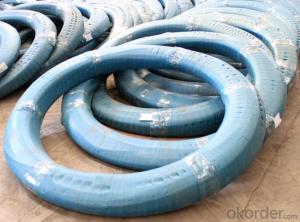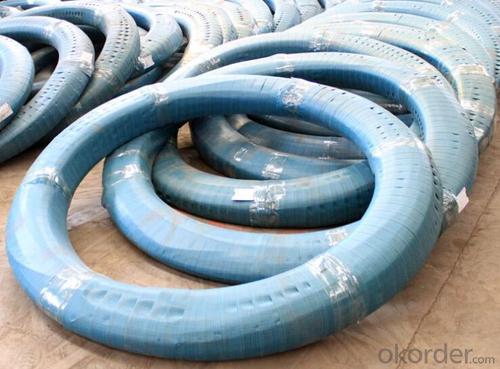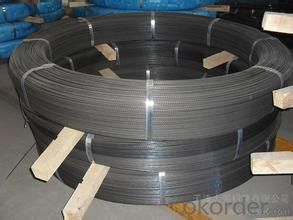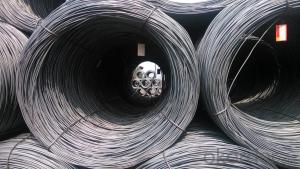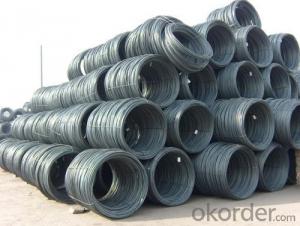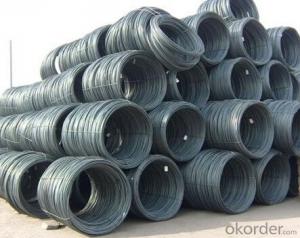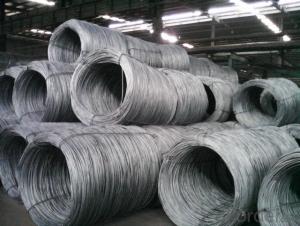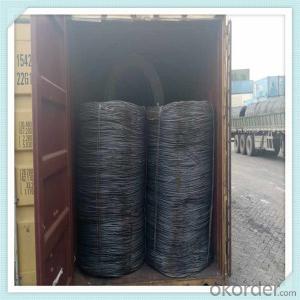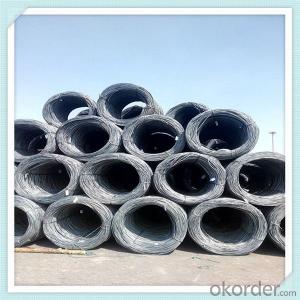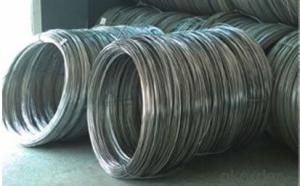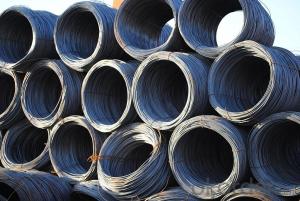Strand Hot Rolled Steel Wires
- Loading Port:
- China Main Port
- Payment Terms:
- TT or LC
- Min Order Qty:
- -
- Supply Capability:
- -
OKorder Service Pledge
OKorder Financial Service
You Might Also Like
Quick Details
| Steel Grade: | SWRH77B, SWRH82B | Standard: | ASTM,BS,GB,JIS | Wire Gauge: | 4.0mm-10.0mm |
| Place of Origin: | Tianjin China (Mainland) | Type: | Drawn Wire,Spiral/Helical Ribs, Round Plain | Application: | Construction |
| Alloy Or Not: | Is Alloy | Special Use: | Free Cutting Steel | Model Number: | 4.0-10.0mm |
| Product Name: | prestressed steel wire 4mm high carbon steel wire | Size: | 4.0-10.0mm | ||
| Strength: | 1570/1670/1770/1860 N/mm2 | Relaxation: | Less than 2% (1000hour) | Elongation: | Not less than 4% |
| MOQ: | 10 Tons | Payment: | TT, LC | Delivery: | 10-15 work days |
| Package: | As your requirements |
Packaging & Delivery
| Packaging Detail:steel strand coil to be packed in damp proof materials strapped with 8 bands on one wooded pallet with an outer layer of plastic used for anti-rainshower 2 or 3 wooden block undermeath each coil. | |
| Delivery Detail:within 2 weeks |
Specifications
high carbon class A steel wire
Constructon:7 steel wire
material:wire 82B
FAQ of Strand Steel Wires
①How is the quality of your products?
Our products are manufactured strictly according to national and internaional standard. If you want see our quality certifications and all kinds of testing report, please just ask us for it.
Guaranteed: If products’ quality don’t accord to discription as we give or the promise before you place order, we promise 100% refund.
②How about price?
Yes, we are factory and be able to give you lowest price below market one, and we have a policy that “ for saving time and absolutely honest business attitude, we quote as lowest as possible for any customer, and discount can be given according to quantity”,if you like bargain and factory price is not low enough as you think, just don’t waste your time.Please trust the quotation we would give you, it is professional one.
③Why should you chose us?
Chose happens because of quality, then price, We can give you both.Additionally, we can also offer professional products inquiry, products knowledge train(for agents), smooth goods delivery, exellent customer solution proposals.Our service formula: good quality+good price+good service=customer’s trust
SGS test is available, customer inspection before shipping is welcome, third party inspection is no problem.
Strand Hot Rolled Steel Wires Images
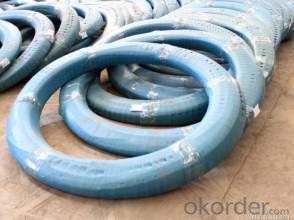
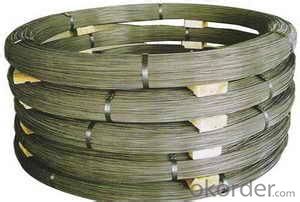
Any question, pls feel free to contact us !
- Q: What are the different surface coating removal methods for steel wire rod?
- There are several surface coating removal methods for steel wire rods, including mechanical methods such as sanding or grinding, chemical methods like acid stripping or chemical solvents, and thermal methods like flame or heat treatment.
- Q: What are the growth prospects for the steel wire rod market?
- The growth prospects for the steel wire rod market are promising due to increasing demand from various industries such as construction, automotive, and manufacturing. Additionally, the growing use of steel wire rods in infrastructure development projects and the rising trend of electric vehicles are expected to further drive market growth.
- Q: How are steel wire rods used in the production of wire ropes for ships?
- Steel wire rods are of utmost importance in manufacturing wire ropes for ships. These rods serve as the primary material for producing wire ropes. To begin with, steel wire rods undergo a series of processes to convert them into wire strands. This entails drawing the rods through multiple dies to decrease their diameter and increase their length. This process ultimately forms thin and elongated wire strands. Subsequently, these wire strands are twisted together to form a cable core. The number of strands used and the direction of the twist depend on the specific requirements of the wire rope. This cable core provides the foundation and strength for the wire rope. Once the cable core is established, it is typically enveloped with an outer layer known as the wire rope's outer strands. These outer strands are also produced using steel wire rods. They are twisted around the cable core in a specific pattern to ensure strength, flexibility, and durability. The utilization of steel wire rods in manufacturing wire ropes for ships is crucial due to the exceptional properties of the material. Steel is renowned for its high tensile strength, resistance to corrosion, and durability, making it an ideal choice for maritime applications. These characteristics enable wire ropes made from steel wire rods to withstand the extreme forces and harsh environments encountered at sea. In conclusion, steel wire rods play a vital role in the production of wire ropes for ships. These rods are transformed into wire strands, which are then twisted together to create the cable core. The cable core is further encased with outer strands, resulting in a robust and resilient wire rope capable of enduring the demanding conditions of maritime operations.
- Q: What are the main factors affecting the worker safety in steel wire rod production?
- The main factors affecting worker safety in steel wire rod production include: 1. Machinery and equipment: The operation of heavy machinery and equipment poses risks such as entanglement, crushing, and falling objects. Regular maintenance, training, and proper guarding of machinery are crucial to ensure worker safety. 2. Hazardous materials: Steel wire rod production involves the handling and processing of potentially hazardous substances such as chemicals, gases, and hot metals. Adequate training, usage of personal protective equipment (PPE), and implementation of proper handling procedures are essential to minimize exposure and prevent accidents. 3. Manual handling and ergonomics: Workers in this industry often engage in physically demanding tasks such as lifting heavy objects, bending, and repetitive motions. Failure to provide proper training, ergonomic workstations, and regular breaks can lead to musculoskeletal disorders and injuries. 4. Heat and fire hazards: Steel wire rod production involves high temperatures, molten metal, and open flames, which pose significant fire and burn hazards. Implementation of effective fire prevention and suppression systems, heat-resistant clothing, and proper training are essential to ensure worker safety. 5. Noise and vibration: Continuous exposure to high levels of noise and vibrations from machinery and equipment can lead to hearing loss, fatigue, and other long-term health issues. Regular noise monitoring, engineering controls, and provision of hearing protection are necessary to protect workers from these hazards. 6. Slip, trip, and fall hazards: The presence of slippery surfaces, uneven floors, and clutter in the production area increases the risk of slip, trip, and fall accidents. Regular housekeeping, proper signage, and use of anti-slip flooring can help mitigate these hazards. 7. Electrical hazards: Steel wire rod production involves the use of electrical equipment, which can pose risks of electric shock, fires, and explosions. Adequate training, regular inspections, and compliance with electrical safety standards are essential to prevent such incidents. Overall, a comprehensive approach that includes proper training, implementation of safety protocols, regular risk assessments, and ongoing monitoring is necessary to ensure worker safety in steel wire rod production.
- Q: How is steel wire rod used in the production of wire mesh baskets for industrial applications?
- The production of wire mesh baskets for industrial applications heavily relies on steel wire rod. This rod acts as the main raw material for creating the wire mesh. To manufacture the wire mesh baskets, the steel wire rod undergoes a process called wire drawing. This process involves passing the rod through a series of dies to decrease its diameter and increase its length. As a result, a long and continuous wire is formed, which is thinner and more flexible than the original rod. The drawn wire is then woven into a mesh pattern using a machine. This weaving process creates a flexible and sturdy structure, with the size of the mesh varying based on the specific requirements of the application. Once the wire mesh is formed, it is usually cut into the desired shape and size to create the basket. The wire mesh can be easily manipulated and bent into different configurations, making it perfect for constructing baskets with specific dimensions and designs. The choice of steel wire rod in the production of wire mesh baskets is justified by its high strength and durability. Industrial applications often demand baskets capable of withstanding heavy loads or harsh environments, and steel wire provides the necessary strength and resilience. Additionally, the wire mesh structure allows for excellent visibility and airflow, making it suitable for various industrial purposes such as storage, transportation, and handling of goods. It offers secure containment while facilitating easy inspection and ventilation. In conclusion, steel wire rod plays a vital role in the production of wire mesh baskets for industrial applications. Its versatility, strength, and durability make it an ideal choice for creating baskets that can endure demanding conditions and effectively store and transport goods.
- Q: How is the impact resistance of steel wire rod tested?
- The impact resistance of steel wire rod is typically tested using a Charpy impact test. In this test, a notched specimen of the wire rod is subjected to a swinging pendulum that strikes and breaks the specimen. The energy absorbed by the specimen during fracture is measured, which provides an indication of its impact resistance.
- Q: What are the factors affecting the price of steel wire rods?
- There are several factors that can affect the price of steel wire rods. These factors include: 1. Supply and demand: The balance between the supply and demand of steel wire rods in the market can greatly influence their prices. If the demand for steel wire rods exceeds the available supply, prices tend to rise. Conversely, if there is a surplus in supply, prices may decrease. 2. Raw material costs: The cost of raw materials required to produce steel wire rods, such as iron ore and coal, can impact their prices. Fluctuations in the prices of these inputs can have a direct effect on the overall cost of production and, consequently, the price of steel wire rods. 3. Energy costs: The energy-intensive nature of steel production means that changes in energy prices, including electricity and fuel costs, can significantly impact the price of steel wire rods. Higher energy costs can result in increased production expenses and lead to higher prices for the end product. 4. Currency exchange rates: Steel wire rods are often traded internationally, and changes in currency exchange rates can influence their prices. If the currency of a steel-producing country weakens against other currencies, it can make their exports more competitive, potentially leading to lower prices in the global market. 5. Government policies and regulations: Government policies, such as tariffs, import/export restrictions, and environmental regulations, can affect the price of steel wire rods. Trade barriers, for example, can limit the supply of steel wire rods from certain regions, leading to higher prices. Additionally, stricter environmental regulations may increase production costs, which can be passed on to consumers as higher prices. 6. Technological advancements: Advances in technology and production techniques can impact the cost of manufacturing steel wire rods. If new technologies allow for more efficient production methods, it can reduce costs and potentially lower prices. Conversely, if new technologies require significant investments or result in higher quality products, prices may increase. Overall, the price of steel wire rods is influenced by a combination of market forces, input costs, government policies, and technological advancements. Understanding these factors is crucial for industry participants and consumers to make informed decisions and anticipate price fluctuations in the steel wire rod market.
- Q: How does the corrosion resistance of steel wire rod vary with different surface treatments?
- Different surface treatments can greatly affect the corrosion resistance of steel wire rod. These treatments are used to improve the wire rod's ability to withstand corrosion and extend its lifespan. One common treatment for steel wire rod is galvanization, which involves applying a layer of zinc to the surface. This zinc coating acts as a sacrificial barrier, protecting the steel underneath from corrosion. Galvanized steel wire rod offers excellent corrosion resistance and can endure harsh conditions like high humidity or corrosive chemicals. Phosphating is another treatment option for steel wire rod. It entails applying a phosphate coating to the surface, enhancing its resistance to corrosion. This coating forms a protective layer, preventing rust formation and halting the spread of corrosion. Furthermore, steel wire rod can be coated with various substances, such as epoxy or polymers, to provide an additional layer of defense against corrosion. These coatings act as barriers, preventing moisture and corrosive substances from reaching the steel surface. Coated steel wire rod exhibits improved corrosion resistance and can be used in environments where direct exposure to moisture or corrosive agents is expected. It is important to note that the effectiveness of surface treatments in enhancing corrosion resistance can vary depending on specific conditions and the quality of the treatment. Factors like coating thickness and adhesion, presence of defects or impurities, and the type and concentration of corrosive substances in the environment can all impact the corrosion resistance of steel wire rod. In conclusion, the corrosion resistance of steel wire rod can be significantly improved through surface treatments like galvanization, phosphating, or the application of coatings. These treatments create protective barriers that ensure the wire rod's longevity and durability in different environments.
- Q: How does steel wire rod compare to other materials in terms of strength and durability?
- Steel wire rod is widely regarded as one of the strongest and most durable materials available in the market. When compared to other materials, such as aluminum or copper, steel wire rod boasts superior strength and durability. Firstly, steel wire rod has an exceptional tensile strength, meaning it can withstand significant pulling forces without breaking or deforming. This strength is crucial in applications where the material is subjected to heavy loads or high-stress conditions. In comparison, aluminum or copper wire rod would typically have lower tensile strength, making them more susceptible to deformation or breakage under similar circumstances. Additionally, steel wire rod exhibits remarkable durability due to its resistance to corrosion, wear, and fatigue. Steel has a natural ability to withstand adverse environmental conditions, making it suitable for various harsh environments, including outdoor or marine applications. On the other hand, materials like aluminum or copper are more prone to corrosion and wear, which can compromise their strength and longevity over time. Moreover, steel wire rod offers excellent structural integrity, allowing it to maintain its strength and shape even when exposed to extreme temperatures or heavy mechanical stress. This characteristic makes steel wire rod highly suitable for demanding applications where safety and reliability are paramount, such as construction, automotive, or aerospace industries. Comparatively, materials like aluminum or copper may experience greater deformation or loss of strength under similar conditions. In conclusion, steel wire rod surpasses other materials in terms of strength and durability. Its exceptional tensile strength, resistance to corrosion and wear, as well as its ability to withstand extreme conditions, make it the preferred choice in numerous industries. Whether it is used for structural purposes, reinforcement, or support, steel wire rod consistently delivers superior performance, ensuring reliability and longevity in various applications.
- Q: How is steel wire rod used in the manufacturing of wire mesh for concrete reinforcement?
- Steel wire rod is an essential component in the manufacturing of wire mesh for concrete reinforcement. Wire mesh is a grid-like structure made from interconnected steel wires, and it serves to enhance the strength and durability of concrete structures. Steel wire rod is used as the primary material for producing the wires that form the mesh. The rod is typically made from carbon steel and undergoes a series of processes to transform it into the desired wire diameter and tensile strength. These processes include hot rolling, pickling, and drawing. Once the steel wire rod has been transformed into wire, it is then formed into a mesh pattern through a weaving or welding process. The mesh pattern can vary, with common options being square or rectangular openings. The spacing between the wires is usually determined based on the specific requirements of the concrete project. During the manufacturing process, the wire mesh is carefully designed to provide reinforcement to concrete structures. When concrete is poured, the wire mesh is placed within it, creating a network of interconnected wires that help distribute the load evenly. This reinforcement significantly improves the concrete's resistance to cracking and breaking under stress, such as from heavy loads or temperature changes. Additionally, wire mesh also helps to control shrinkage and prevent the formation of large cracks in the concrete. By restricting the movement of individual concrete elements, the mesh ensures that any cracks that do form are smaller and more manageable. In summary, steel wire rod plays a crucial role in the manufacturing of wire mesh for concrete reinforcement. It is transformed into wire, which is then woven or welded into a mesh pattern. This mesh is placed within concrete structures to enhance their strength, durability, and resistance to cracking and breaking.
Send your message to us
Strand Hot Rolled Steel Wires
- Loading Port:
- China Main Port
- Payment Terms:
- TT or LC
- Min Order Qty:
- -
- Supply Capability:
- -
OKorder Service Pledge
OKorder Financial Service
Similar products
Hot products
Hot Searches
Related keywords
